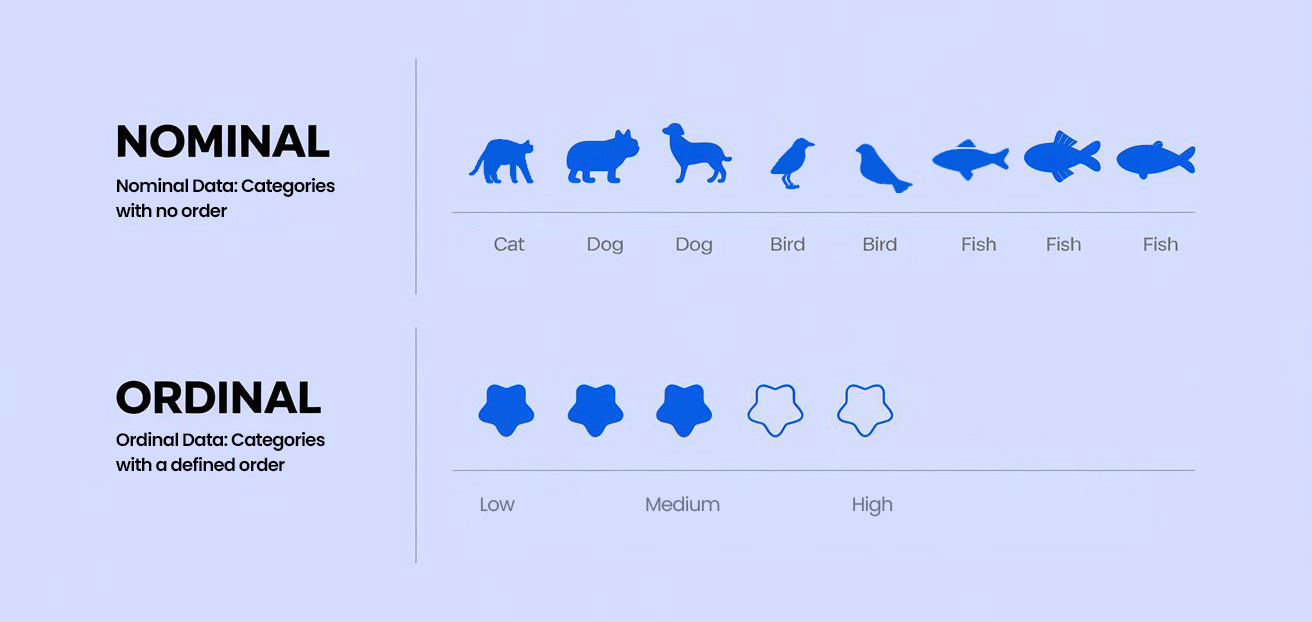Survey design plays a critical role in data collection, and the types of questions you ask directly impact the quality and relevance of your insights.
In this article, we’ll dive into the key differences between nominal and ordinal survey questions, offering practical examples and showcasing how each type can be effectively used in your surveys.
Introduction to Survey Questions: Nominal vs. Ordinal
In survey research, nominal and ordinal questions serve as foundational elements.
These two types are essential for gathering accurate and actionable data, but they differ significantly in structure and purpose.
- Nominal Questions: Categorize responses without implying any order.
- Ordinal Questions: Rank responses to indicate relative importance or preference.
Understanding these distinctions is key to designing surveys that align with your research objectives. When properly used, these question types can uncover valuable patterns and relationships within your data.

What Are Nominal Questions?
Nominal questions are designed to categorize data into distinct groups without any inherent order.
These questions focus on collecting categorical information such as names, locations, or demographic details. The responses do not imply a ranking, making them ideal for gathering basic, non-hierarchical information.
For example, asking a respondent’s gender, favorite smartphone brand, or country of residence falls under nominal questions.
Examples of Nominal Survey Questions:
- Gender:
- Male
- Female
- Non-binary
- Prefer not to say
- Location:
- United States
- Canada
- United Kingdom
- Other
- Education Level:
- High School
- Bachelor’s Degree
- Master’s Degree
- Doctorate
- Favorite Smartphone Brand:
- Apple
- Samsung
- Other
- Political Affiliation:
- Democrat
- Republican
- Independent
- Other
Nominal questions are easy to analyze using basic statistical techniques like frequency analysis or cross-tabulation. They are particularly useful in customer segmentation and market research where categorization is essential.
What Are Ordinal Questions?
Ordinal questions introduce a sense of order or ranking. They measure relative preferences, satisfaction levels, or opinions by asking respondents to rank or rate their responses. While they provide insight into the sequence or importance of items, the intervals between choices are not necessarily equal.
For example, asking respondents to rate their satisfaction on a scale from 1 to 5 or to rank product features from most to least important are ordinal questions.
Examples of Ordinal Survey Questions:
- Satisfaction Rating:
- Very Satisfied
- Satisfied
- Neutral
- Unsatisfied
- Very Unsatisfied
- Likelihood to Recommend:
- Very Likely
- Likely
- Neutral
- Unlikely
- Very Unlikely
- Importance of Features:
- Very Important
- Important
- Neutral
- Unimportant
- Very Unimportant
- Speed of Service:
- Less than 1 hour
- 1–3 hours
- Within 24 hours
- 1–2 days
- More than 2 days
Ordinal questions are widely used in customer satisfaction surveys, helping businesses prioritize improvements based on customer preferences.
Sample Survey Incorporating Nominal and Ordinal Questions
To illustrate how nominal and ordinal questions work together in a survey, let’s look at an example of a customer feedback form for a new smartphone.
This sample survey combines both nominal and ordinal questions to gather comprehensive data about customer demographics, satisfaction levels, and feature preferences.
Key Differences Between Nominal and Ordinal Questions
The primary difference lies in how they classify data:
- Nominal Questions: Group respondents into categories without order.
- Ordinal Questions: Provide insights into the order or ranking of preferences.
Comparison Table:
| Aspect | Nominal Questions | Ordinal Questions |
|---|---|---|
| Data Type | Categories without order | Ranked data with order |
| Measurement Level | Nominal Scale | Ordinal Scale |
| Statistical Analysis | Frequency counts, Mode | Median, Percentiles |
| Examples | Gender, Location, Brand | Satisfaction Rating, Importance Levels |
| Analysis Techniques | Chi-square test, Cross-tabulation | Spearman’s rank correlation, Mann-Whitney U test |
Best Practices for Crafting Effective Survey Questions
When designing your survey, keep these best practices in mind:
✔️ Do:
- Clarity: Ensure questions are straightforward and easy to understand.
- Logical Flow: Organize questions to maintain a smooth progression.
- Align with Objectives: Each question should serve your data collection goals.
- Use Simple Language: Avoid jargon or complex terms.
❌ Don’t:
- ❌ Use Leading Questions: Avoid biasing responses with suggestive wording.
- ❌ Overcomplicate Questions: Don’t confuse respondents with multiple ideas in one question.
- ❌ Assume Knowledge: Don’t presume respondents know industry-specific terms.
Example of a Leading Question to Avoid:
- ❌ “Don’t you agree that our product is the best in the market?”
Revised for Clarity:
- ✔️ “How would you rate our product compared to others in the market?”
Analyzing Nominal and Ordinal Data
Proper analysis is crucial for actionable insights.
Analyzing Nominal Data:
- Frequency Analysis: Count how many respondents select each category.
- Cross-tabulation: Compare categorical variables to find patterns.
- Chi-square Test: Determine if there is a significant association between two nominal variables.
Analyzing Ordinal Data:
- Spearman’s Rank Correlation: Assess relationships between ranked variables.
- Mann-Whitney U Test: Compare differences between two independent groups.
- Ordinal Regression: Model the relationship between an ordinal dependent variable and one or more independent variables.
These techniques help you draw conclusions and make data-driven decisions for marketing strategies, product development, or service enhancements.
For more on analyzing survey data, check out Qualtrics’ guide on Likert Scale data analysis.
Elevate Your Surveys with Effective Tools
Now that you understand nominal and ordinal questions, it’s time to implement them in your surveys. Using an effective survey tool can make this process seamless.
Benefits of Using a Survey Tool:
- User-Friendly Interface: Design professional surveys with a drag-and-drop builder.
- Customizable Templates: Tailor surveys to your specific needs.
- Real-Time Analytics: Gain powerful insights from your data.
- Responsive Design: Ensure your surveys look great on all devices.
- Advanced Features: Utilize skip logic, question branching, and more.
Whether you need simple categorical questions or detailed ranking scales, a good survey tool provides the features to gather meaningful data efficiently.
Conclusion: Mastering Nominal and Ordinal Survey Questions
Understanding the difference between nominal and ordinal questions is essential for creating surveys that capture the right kind of data.
- Nominal Questions: Help you categorize and segment your audience.
- Ordinal Questions: Provide insights into preferences and satisfaction levels.
By combining both in a well-structured survey, you gather data that’s both comprehensive and actionable.
As you embark on your next survey project, remember to use the right type of question to enhance data quality and inform your decisions.
FAQs
What is a nominal survey question?
A nominal survey question categorizes responses without any inherent order, such as gender, location, or favorite brand.
How do ordinal survey questions differ?
Ordinal questions rank responses in a specific order, such as satisfaction levels or likelihood to recommend, but the intervals between choices are not necessarily equal.
Why is using both nominal and ordinal questions important?
Using both types allows for a more nuanced understanding of your respondents, providing both categorical insights and information about preferences or rankings.
How can Veeform help with survey creation?
Veeform simplifies survey design with customizable templates, drag-and-drop tools, and advanced analytics for both nominal and ordinal data.
What analysis techniques should I use for nominal and ordinal data?
Nominal data is often analyzed with frequency analysis or chi-square tests, while ordinal data uses techniques like Spearman’s rank correlation or ordinal regression.
